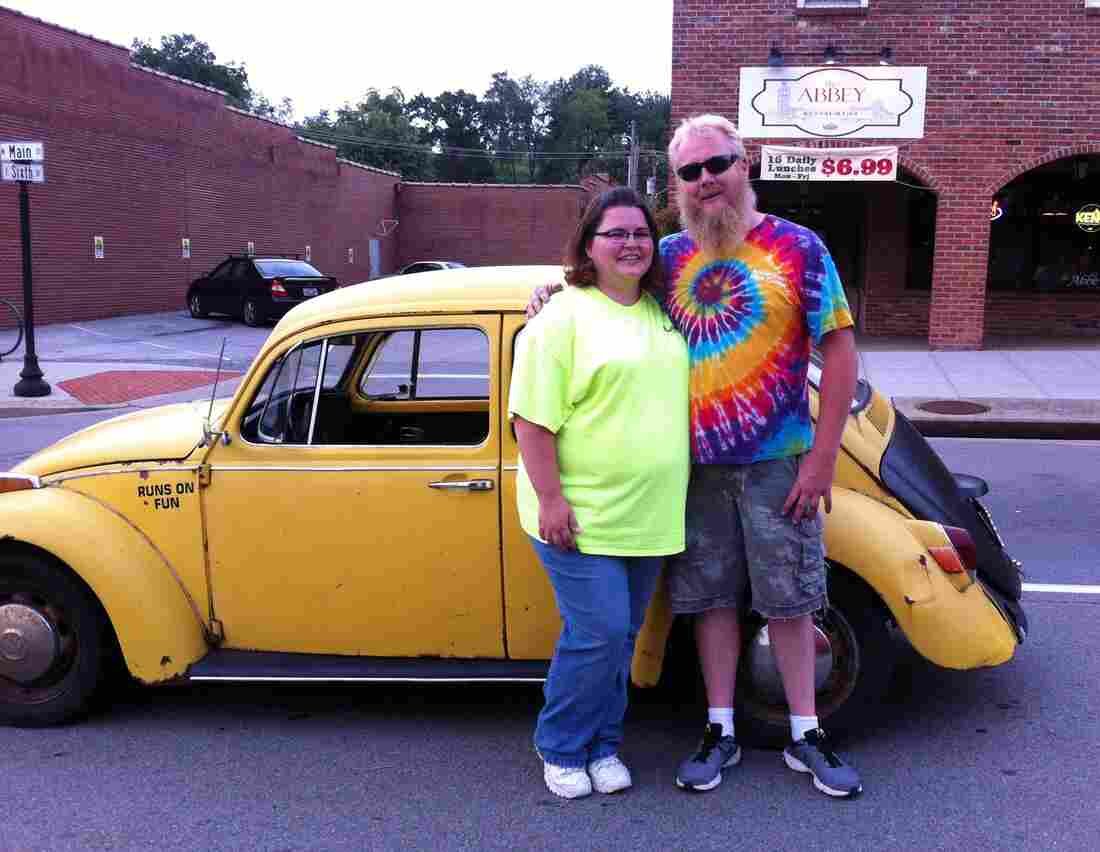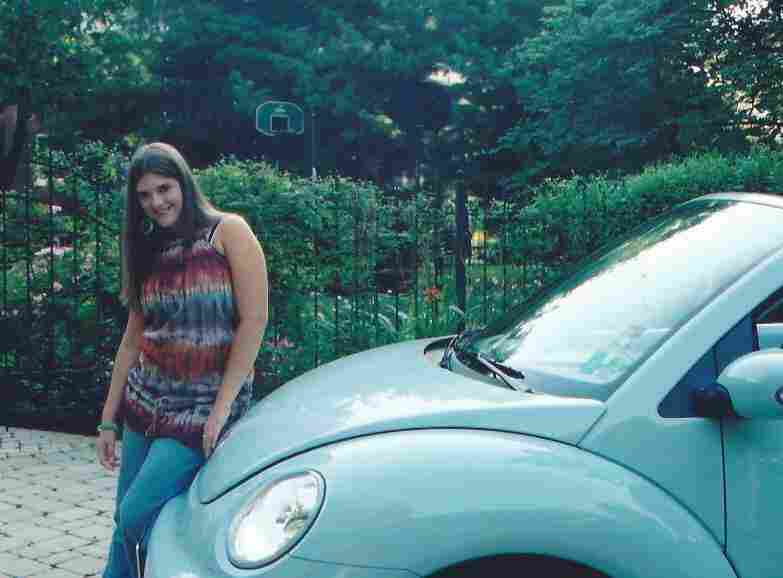A Bug’s Life: Remembering The Classic Volkswagen Beetle

Jessica Bray and her husband, Anthony Bray, pose with their 1970 Volkswagen Beetle. Anthony converted his Beetle to an electric car. “As a special touch, we added bubble machines to the back to blow bubbles at car shows and as we drive,” Jessica said.
Courtesy of Jessica Bray
hide caption
toggle caption
Courtesy of Jessica Bray
At one time, the Volkswagen Beetle was so ubiquitous that its sighting is often punctuated by a swift punch in the arm and a shout of “Punch Buggy!” (Or “Slug Bug!” depending on your regional take on the road trip game).
But this week, the Beetle set off down the road to extinction. On Wednesday, Volkswagen ended production of the Beetle, saying it wants to set its sights on manufacturing electric vehicles.
Over the decades, Volkswagen managed to revamp the beloved car’s image by distancing itself from an uncomfortable history.
The original Beetle was formulated by Adolph Hitler, who wanted a “people’s car,” or “volkswagen.” But the car wasn’t actually produced for civilians until the late 1940s, when the victorious Allies wanted to refuel Germany’s economy.
Many rebranding campaigns later, a hipster favorite was born.
For many Beetle owners, bidding adieu to the automotive icon summons nostalgia.
NPR asked its audience to share their favorite Volkswagen Beetle memories. More than 900 of you wrote in. We’ve excerpted just a handful of your stories — both fond and unpleasant — below.
Hippie’s best friend
Kristine Smith’s parents gifted her a 2005 robin egg blue convertible Beetle for her 16th birthday.
Although the car better withstood her college move to Los Angeles than her Chicago winter back home, the car accessorized her patched-up denim and her long and flowy tie-dye skirts that she procured from eBay.
“I was obsessed with all things hippie/bohemian in high school, and my Beetle was core to my identity,” she said in an interview with NPR’s Michel Martin.
Kristine Smith, pictured in 2005, when she first got her robin egg blue convertible Beetle for her 16th birthday.
Courtesy of Kristine Smith
hide caption
toggle caption
Courtesy of Kristine Smith
Regrettably, she said, she sold it in 2013 to use the money for graduate school in Washington, D.C.
“The car definitely feels like a pet I once had than a piece of machinery,” she said.
But, as a souvenir for her first and only car, Smith did hold onto the fake flowers she kept in the vase next to the steering wheel.
Burned into memory
A hot summer day in Oklahoma was too much for Robert Rillo’s family Beetle.
When he was 13, he and his 23-year-old sister were stuck in traffic on the way to a Huey Lewis and the News concert.
Rillo remembered that his sister’s friend sitting in the back seat said, “It’s getting hot in here.”
“It was a hot summer day so we didn’t think too much about it, until he says again, ‘It’s getting real hot!’ Suddenly he jumped up and the back seat was on fire.”
The battery, located under the backseat, was heating up — catching the seat on fire. Damage control ensued.
“We yanked the seat out of the car and put it out and went in to the concert.”
Alas, they missed the show’s opening act: Stevie Ray Vaughan — who’s famous, as it happens, for his album Couldn’t Stand the Weather.
Love Bug
Paul Weidenbach of Topeka, Kan., said he vowed to the previous owner of his first car that he would keep “Gladys” as its name.
The third-hand 1973 Super Beetle, with a Starsky and Hutch stripe trimming its top and sides, witnessed Weidenbach’s first love.

Paul Weidenbach in 1984, with his first car, a black-and-yellow Beetle named Gladys.
Courtesy of Paul Weidenbach
hide caption
toggle caption
Courtesy of Paul Weidenbach
“My high school sweetheart, Vicky, and I made the rounds with Gladys’ help, including a drive-in movie where we made Vicky’s 6-year-old brother, Matt, sit on the roof during Jungle Book at the Chief Drive-In in Topeka,” he said. “In full disclosure, we only talked and held hands.”
He hadn’t spoken to Vicky since 1991, but last year, he said, she died unexpectedly. When he went to her funeral, the memory returned in full force. “Of course, that night at the Chief Drive-In with Matt on the roof played over and over again in my mind,” he recalled.
As for Gladys, Weidenbach said, her motor has reincarnated as a rare 1950’s VW truck.
“We were ahead of our time!”
You could say Jessica Bray’s husband crept into her life. Bray met him five years ago when she was serving as chair of a local car show in Kentucky.
“As cars were lining up to park, here comes a guy driving a silent VW Beetle,” she said.
After striking up a conversation with him, she learned that he’d converted his ’70 Beetle to an electric vehicle by switching out the motor for a forklift motor and adding batteries, she said. They went out to dinner together that night.
“Six months later, he asked me to be his wife,” she said.
Now Volkswagen says it’s dumping the classic model to pour money into electric car ventures.
“We were ahead of our time!” she said.
Paint it black
In high school, “cool” came before comfort for Damian Rodriguez.
When his mother gave him her baby blue ’73 Bug in 1991, he painted it black to make it “less ‘mom-like.’ “
In sweltering Austin, his parents thought the idea was crazy. The car didn’t even have AC. “I sweated so much in that car, but I loved it and have many great memories of it,” Damian said.
But when a milkman totaled the Bug while delivering to the grocery store where he worked, he said, “I was literally crushed.”
So when he recently came across a die-cast, black ’70s VW Bug toy car, he gave it to his 2-year-old.

Damian Rodriquez gave his son, Diego, a toy replica of his black ’70s-era Bug.
Courtesy of Damian Rodriguez
hide caption
toggle caption
Courtesy of Damian Rodriguez
But as it happens — like father, like son.
He dropped it, cracking the back brake light, Rodriguez said, “ironically making it more like my Bug was.”
NPR’s Eliza Dennis and Natalie Winston produced and edited this story for broadcast.
Simona Halep Defeats Serena Williams To Win Her First Wimbledon Title

Serena Williams is dejected after losing a point during the women’s singles final match against Romania’s Simona Halep at Wimbledon on July 13, 2019.
Kirsty Wigglesworth/AP
hide caption
toggle caption
Kirsty Wigglesworth/AP
Serena Williams went into the Wimbledon finals on Saturday hoping to secure her 24th Grand Slam singles title — an accomplishment that would have equaled the record set by Margaret Court in the 1970s.
But after losses in two sets — 6-2, 6-2 — she fell to 27 year old Simona Halep, who with the victory became the first Romanian player to win a singles title at Wimbledon.
The win marked Halep’s second major singles title — she previously won the the French Open in 2018.
From the beginning, Halep dominated the match against Williams, controlling the court with her speed, coverage and aggressive ground strokes. When Williams failed to return the final rally that clinched the match, Halep sank to her knees and raised her racket high above her head, closing her eyes and grinning in triumph.
After the match ended, Halep was asked if she’d ever played better.
“Never,” she said. “It was the best match.”
But Halep had kind words for Williams as well.
“Serena has inspired us, so thank you for that,” she said.
Saturday’s match was Williams’ 11th Wimbledon singles final. She’s won the tournament seven times already, most recently in 2016 against Angelique Kerber.
The match was also the third Grand Slam loss in a row for Williams, who hasn’t won a Grand Slam title since the Australian Open in 2017, which she played while pregnant. She lost to Kerber in last year’s Wimbledon final and to Naomi Osaka at the U.S. Open in September.
At 37, Williams is the oldest Grand Slam women’s singles finalist to compete since the start of the Open Era in 1968. But she has struggled to attain her 24th Grand Slam singles title since the birth of her daughter, Olympia, in 2017.
Her daughter’s birth “would have been a perfect moment to walk away, but I wanted more,” she said in an interview last year.
After the match, Williams said playing against Halep made her feel like a “deer in the headlights.”
“When a player plays like that, you just have to take your hat off,” she said.
But Williams said this is far from her last tournament. “I’ve just got to keep fighting, keep trying,” she said. “I love playing the sport.”
Overhauling Kidney Care
This week, President Trump signed an executive order aimed at improving the care of kidney patients. Nephrologist Amaka Eneanya talks with Scott Simon about some of the new initiatives.
SCOTT SIMON, HOST:
Americans with kidney disease got some encouraging news when President Trump signed an executive order aimed at improving their care.
(SOUNDBITE OF ARCHIVED RECORDING)
PRESIDENT DONALD TRUMP: Those who suffer from kidney disease experience a significant toll on their daily lives.
SIMON: The administration wants to improve detection and diagnosis, increase the number of kidney transplants and move patients away from commercial dialysis centers by encouraging more in-home dialysis. Medicare now spends about $114 billion on kidney care every year, about a third of that on people who need regular dialysis or a transplant.
Dr. Amaka Eneanya is a nephrologist with Penn Medicine at the University of Pennsylvania. She treats patients with chronic kidney disease. Thanks very much for being with us.
AMAKA ENEANYA: Thank you for having me on, Scott.
SIMON: The scope of kidney illness in this country is enormous, isn’t it?
ENEANYA: That’s correct. So approximately 37 million adults have chronic kidney disease in United States. And the majority of those adults are unaware of their diagnosis, upwards of 90%.
SIMON: One of the proposals, and certainly one that a lot of people noticed, is encouraging patients to have dialysis at home…
ENEANYA: That’s correct.
SIMON: …Which I gather is common in some countries around the world, but not the United States. Why not so far?
ENEANYA: So there’s a few reasons for that. So one, the training for clinicians who actually do provide care for patients with kidney disease is not very robust for home dialysis. Also, the payment incentives, as they are now, really favor doing dialysis in in-center dialysis facilities. Also, education for patients is still evolving for them to learn about home dialysis.
SIMON: How do you do home dialysis?
ENEANYA: Basically, what your kidneys do is to, on a regular, you know, 24/7 basis, clean the body of fluid and waste. And that’s basically what your urine is. And so when you’re doing home dialysis, you have machines that are actually doing this for you. So you’re connecting to this machine, and it’s removing fluid and waste from the body, just as your kidneys would do.
SIMON: And this works overseas?
ENEANYA: This works incredibly well. Countries – Guatemala, Mexico, Hong Kong have the majority of their patients using some type of home dialysis.
SIMON: I noticed some medical sources this week, in response to the president’s plan, said, look; what we have is working now. Why endanger that?
ENEANYA: The question is who is it working for? If it’s working for the patients and we have a resounding response from them that that’s what the case is, then by all means, we should reconsider and look at things very closely. But that’s not what research has shown, and that’s not what my experience has been, and many others, in terms of caring for these patients. It’s quite a burden to do things the way that they have been doing, which is most of the patients going to dialysis or receiving their dialysis in a facility.
SIMON: The administration wants to double the number of kidneys available for transplant. How do you do that?
ENEANYA: Part of what he was describing was incentivizing donors – paying them for lost wages and child care that they may have to use after doing a surgery. I think a lot of the time, there’s a focus on the recipient because they have this chronic disease, and they’re getting a fresh, new kidney, and great for them. But I recently had an experience where I spoke to a altruistic donor, so a person who just decided to donate a kidney out of the goodness of their heart. And she really remarked, you know, tearfully, how difficult the post-operative period was and how she really wasn’t prepared for how long she would be…
SIMON: Yeah.
ENEANYA: …Out of work and, you know, how difficult that was. And so I think actually educating donors and providing these incentives will really make a difference.
SIMON: Do you think the executive order signed this week is going to – has the hope of improving life for kidney patients in a couple of years?
ENEANYA: Absolutely. This was a phenomenal kind of monumental time for the field of nephrology and for patients with kidney disease. If the goal is to have 80% of patients with end-stage kidney disease to be on a home dialysis modality or to receive a transplant, that’s a really big change. And so we know that quality of life will be – will improve. Patients will have kind of more choices in terms of what is best for them. It’s really an exciting time.
SIMON: Dr. Amaka Eneanya, a nephrologist with Penn Medicine, University of Pennsylvania. Thanks so much for being with us.
ENEANYA: Thank you so much.
(SOUNDBITE OF MUSIC)
Copyright © 2019 NPR. All rights reserved. Visit our website terms of use and permissions pages at www.npr.org for further information.
NPR transcripts are created on a rush deadline by Verb8tm, Inc., an NPR contractor, and produced using a proprietary transcription process developed with NPR. This text may not be in its final form and may be updated or revised in the future. Accuracy and availability may vary. The authoritative record of NPR’s programming is the audio record.


